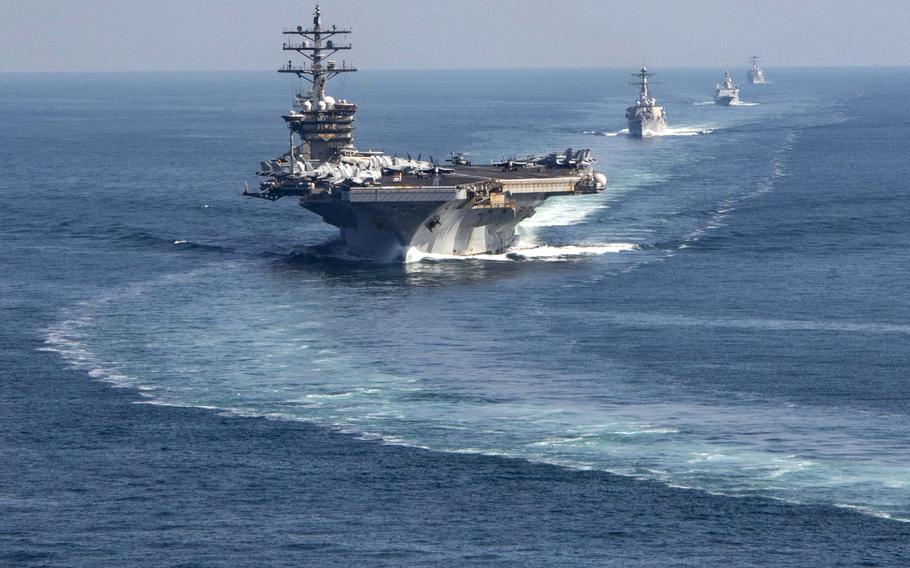The Pentagon has announced that a US Navy warship, the USS Carney, has shot down an Iranian-origin drone launched from Yemen, marking the second such incident in recent weeks.
The drone, launched by Iranian-backed rebels in Yemen, was approaching the Navy vessel near the Bab el-Mandeb strait, a critical waterway connecting the Red Sea and the Gulf of Aden near the Arabian Sea.
The incident occurred around 11 am Yemen time on November 29 in the South Red Sea while the USS Carney was escorting a supply ship and another vessel carrying military equipment to the region.
However, the incident did not result in injuries to American personnel or damage to US property. The US defense officials confirmed that the destroyed drone was an Iranian-made KAS-04.
“Although its intentions are unknown, the UAV was heading toward the warship. At the shoot-down, the USS Carney was escorting the USNS SUPPLY (Oiler) and another US-flagged and crewed ship carrying military equipment to the region,” CENTCOM said in a statement on social media platform X.

According to Air Force Brig. Gen. Pat Ryder, the Pentagon’s chief spokesman, said the Houthi rebels in Yemen, who are in alliance with the Iranian government, maintain a longstanding connection with Iran.
Ryder added, “When it comes to our forces, we will do whatever we need to protect them. I’m not going to telegraph, forecast, or speculate on any potential strikes that we might take in the region other than to say we will do what’s necessary to protect our forces.”
The USS Carney, an Arleigh Burke-class destroyer, has been stationed in the region for several weeks. Its presence in the Middle East is aligned with the broader US initiative to stabilize the area and discourage any escalation by other countries or groups amid the Israeli-Hamas conflict.
Last month, the USS Carney utilized its SM-2 surface-to-air missiles to successfully intercept and shoot down 15 drones and four cruise missiles fired from Yemen in the northern Red Sea within a nine-hour timeframe, according to Fox News.
In early November, the USS Thomas Hudner, a Navy destroyer, intercepted and neutralized a drone approaching the ship while navigating the southern Red Sea near the Bab el-Mandeb Strait.
The Red Sea, extending from Egypt’s Suez Canal to the narrow Bab el-Mandeb Strait that separates the Arabian Peninsula from Africa, holds strategic significance as a critical global shipping lane and a means for transporting energy resources.
Iranian Drone Executes Unsafe Pass In Proximity To USS Dwight D. Eisenhower
The drone attempt marks the latest in a series of threats from Houthi rebels with Iranian backing. This incident occurred just a day after an Iranian drone came within 1,500 yards of the USS Dwight D. Eisenhower aircraft carrier during its flight operations in international waters in the Arabian Gulf.
The Dwight D. Eisenhower Carrier Strike Group, which includes the cruiser USS Philippine Sea and the destroyers USS Mason and USS Gravely, arrived in the Middle East on November 4.
While transiting international waters in the central Persian Gulf on November 28, Eisenhower detected and visually identified an Iranian drone, according to a statement from U.S. Naval Forces Central Command/US 5th Fleet.
Vice Adm. Brad Cooper, NAVCENT commander, said that the Iranian drone’s dangerously close approach to the USS Dwight D. Eisenhower constituted a violation of the daily notice to airmen (NOTAM).
This directive mandates all unmanned and unmanned aircraft to maintain a distance exceeding ten nautical miles from the aircraft carrier to ensure the safety of military and civilian aviation.

Although no damage occurred during the event, Vice Adm. Brad Cooper described Iran’s drone flight as “unsafe, unprofessional, and irresponsible.” However, the US Navy did not disclose whether any actions were taken against the drone by the carrier or its escorts.
The Islamic Revolutionary Guard Corps of Iran also released drone footage on November 28, claiming it was captured as the Eisenhower transited the Strait of Hormuz on November 26.
This narrow chokepoint between the Persian Gulf and the Gulf of Oman has seen increased tensions, with the IRGC characterizing the encounter as an “interception” and expressing concerns about the US presence in the region, causing tension and insecurity.
- Contact the author at ashishmichel(at)gmail.com
- Follow EurAsian Times on Google News




